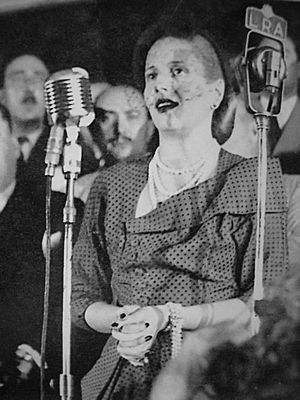Peronism facts for kids

Peronism (also called justicialism) is a big political movement in Argentina. It is based on the ideas of former Argentine president Juan Perón (1895–1974). This movement has been very important in Argentina's history.
Since 1946, Peronists have won many presidential elections. They have won 10 out of 13 elections where they were allowed to run. The main political party for Peronism is the Justicialist Party. While different Peronist presidents have had slightly different ideas, the main goals often include focusing on Argentina's independence, helping workers, and being popular with many different groups of people.
Contents
Juan Perón's Time in Power
Juan Perón became a powerful leader in the Argentine government after a military change in 1943. He was then elected president of Argentina in 1946.
Helping Workers and the Poor
As president, Perón started many programs to help the working class. He strongly supported labor unions, which are groups that protect workers' rights. He also believed the government should be more involved in the country's economy. At the same time, he also helped businesses and factory owners.
Eva Perón's Role
Juan Perón was very popular, and his wife, Eva, made him even more admired. Eva was loved by the people. She worked hard to support the rights of migrant workers and the poor.
Perón's Return
In 1955, due to economic problems, the military removed Perón from power. The Peronist party was banned for many years. It wasn't until 1973 that new elections were held. In that election, Perón was elected president again. However, he passed away the next year. His wife, Isabel, became president after him. After Perón's death, there were many problems and disagreements, and the military removed Isabel from power in 1976.
Later Peronist Leaders
Peronism continued to be a strong force in Argentina, even after Juan Perón's death.
Carlos Menem's Presidency
Carlos Menem, another Peronist, was president from 1989 to 1999. His policies were quite different from earlier Peronists. He focused on selling government-owned businesses to private companies and promoting free-market ideas. He also worked on improving Argentina's relationships with other countries.
The Kirchners' Era
Later, Néstor Kirchner became president in 2003 and served until 2007. His wife, Cristina Fernández de Kirchner, then became president and served from 2007 to 2015. The Kirchners brought back some of the older Peronist ideas. They focused on making Argentina's economy stronger on its own and less dependent on other countries. Their specific ideas are often called Kirchnerism.
Images for kids
-
Néstor Kirchner speaking to a crowd at Gualeguaychú.
See also
 In Spanish: Peronismo para niños
In Spanish: Peronismo para niños




